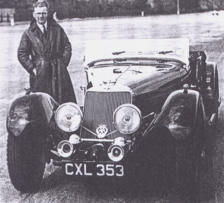
british anzani archive:





of similar capacity to his predecessors but had hemipherical heads and a chain
driven overhead camshaft. Burt’s draughtsmen built Maclures engine and used it
in a test-bed racing car called the Slug (for it's low slung appearance) and the
engine proved very powerful.
Things changed dramatically again for Anzani’s in 1929. Archie Frazer-Nash
temporarily retired from the firm with ill health and the new managing director H.
J. Aldington decided to make some major changes. Firstly he decided to use the
Meadows 4 ED engine in their cars only using the side valve in supercharged
form for racing engines - he also decided against incorporating Anzani into the
business thereby casting adrift what had become their specialist engineering
arm. The situation was made more awkward because Anzani and A.F.N shared
stores and drawing offices in the factory. Some benefit came Anzani’s way in the
fact that they no longer did subsidized work for AFN but the fact remained they
had lost by far their biggest customer. It is also widely recognised that 1929
marked the end for the specialist independent manufacturers of cars and
engines. The surviving builders of cars and motorbikes now built their own
engines and the era of mass production had finally won through. A decision was
made to not look for new orders for engines although they were still made to
order and Burt did his best to help his company through this difficult time by
giving them contract work from Mowlems and for a time they became builders of
concrete mixers and pneumatic road drills. The next traumatic change came
when Aldington announced that the company should move to a new site in
London Road, Isleworth in Middlesex.
In 1931 Frazer-Nash, now out of hospital, resigned from the company and with
Plunkett-Greene already gone after Aldington took over in 1929 many of the old
faces were no longer there. Significantly one new face to join was T.D. Ross
from Austin.
Ross argued for the company to manufacture a new racing engine which would
be sold in a detuned state to sports car manufacturers; an argument which flew
in the face of the current industry thinking. The decision was agreed however
and the R1 (the Ross 1) was put into development. It was a very powerful motor,
producing over 100bhp through it twin Solex’s and twin overhead camshafts.
Much of the internals of the new engine were based on Ross’s experience at
Austin and he was later to comment that it was basically an Austin design and
the tappets he said were pure Austin 7. The problem was there were no
customers for the new engine until one day the young manufacturer Adrian
Squire came to see Ross and his new engine. The deal was clinched when
Ross agreed to cast the Squire name in the cam covers and thereby make his
new car appear an all Squire Car Manufacturing Company product.
Ross made his second engine the R2, a redesign of the old V-twin, for a 500
engine order for the Bristol Tractor Company for a small tractor they were
building and later he got a further order from Bristol for another 1,000 R2
engines. He was also involved in working on a new order from holiday camp
entrepreneur Billy Butlin for their Dodgem Boats and generally things were
looking up for Ross when in August 1933 he fell out with Burt and offered his
resignation on a point of principle and to Ross’s amazement Burt accepted it!
Ross left and joined the Army and Burt went back to his contract work.



Adrian Morgan Squire was born in 1910 in Hoddesdon,
Hertfordshire. At 18 he was an apprentice at Bentley and in 1929 he
was in the drawing office at MG. He inherited the sum of £20,000
and decided to invest it (with the help of his friend Jock Manby-
Colegrave) in making his dream car. By 1932 the first details of the
soon to be released Squire sports car were announced and by 1934
they were on sale but by 1936 they went into voluntary liquidation.
Only seven cars were ever built. Squire returned to Bentley at
Lagonda and was killed in a day time air raid on the Bristol
Aeroplane Co. in 1940 aged 30.







